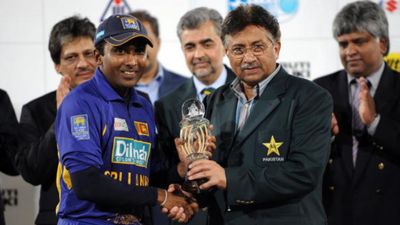The Asia Cup 2023 commences on Wednesday, August 30, with the tournament being co-hosted by Pakistan and Sri Lanka. However, initially, the tournament was supposed to be held entirely in Pakistan, which meant that the neighbouring country to India would be hosting a major cricket tournament for the first time since 2008!
Back then, the 2008 Asia Cup, also known as Star Cricket Asia Cup, was an ODI cricket competition hosted in Pakistan from June 24 to July 6, 2008, spanning two different venues — National Stadium, Karachi and Gaddafi Stadium, Lahore. The participating teams included cricket heavyweights India, Pakistan, Sri Lanka, and Bangladesh, along with associate members from Asia — UAE and Hong Kong.
This edition marked Pakistan's debut as the host nation for the Asia Cup, an opportunity previously denied due to political conflicts with India. In India, the tournament was telecasted on Star Cricket and ESPN, while Geo Super covered it in Pakistan. Sri Lanka emerged as the champions, besting India by a margin of 100 runs in the tournament's finale.
In the 2008 Asia Cup, teams were organised into two distinct groups for the initial stages of the tournament. Group A was comprised of Bangladesh, Sri Lanka, and the United Arab Emirates, while Group B included India, Pakistan, and Hong Kong.
The initial phase was formatted as a round-robin competition within each group. Following this, the top two teams from Groups A and B advanced to the next level of the competition, known as the Super Fours. Here, the teams again engaged in a round-robin battle, with the leading two teams progressing to vie for the championship in the grand final.
The Hybrid Hosting Model: Pakistan and Sri Lanka
The Asia Cup cricket governance took an interesting turn when it was confirmed that the tournament would follow a hybrid hosting model. Of the total 13 Asia Cup matches, four will take place in Pakistan and the remaining nine in Sri Lanka. This adaptation became crucial after India's Asia Cup involvement was clouded by the BCCI stating that the Indian cricket team would not travel to Pakistan.
Najam Sethi, the then chairman of the PCB management committee, expressed enthusiasm about the hybrid format, which allows Pakistan to retain its hosting rights while accommodating Sri Lanka as a neutral venue. The hybrid model was particularly necessary due to the Indian cricket team's constraints against travelling to Pakistan.
Grouping and Format: India vs Pakistan Anticipation
The Asia Cup match line-up places India, Pakistan, and Nepal in one group, and Sri Lanka, Bangladesh, and Afghanistan in another. The top two teams from each group will move on to the Super Four stage, culminating in a final showdown. This time around, matches will revert to the 50-over format, serving as preparation for the upcoming ODI World Cup in India later in the year.
The Political Backdrop and Alternatives
India's refusal to play in Pakistan was due to political tensions between the two nations. The PCB, keen to have a portion of the tournament at home, had also considered the UAE as a potential neutral venue. However, concerns were raised by Bangladesh over extreme weather conditions in the Emirates during September.
MORE ON SPORTS TAK
'If you count on skills, both batting and bowling are same': Nepal captain Rohit Paudel's big statement before Asia Cup debut against Pakistan
Significant boycotts in Asia Cup history: India's 1986 episode and Pakistan's 1991 absence
ADVERTISEMENT










